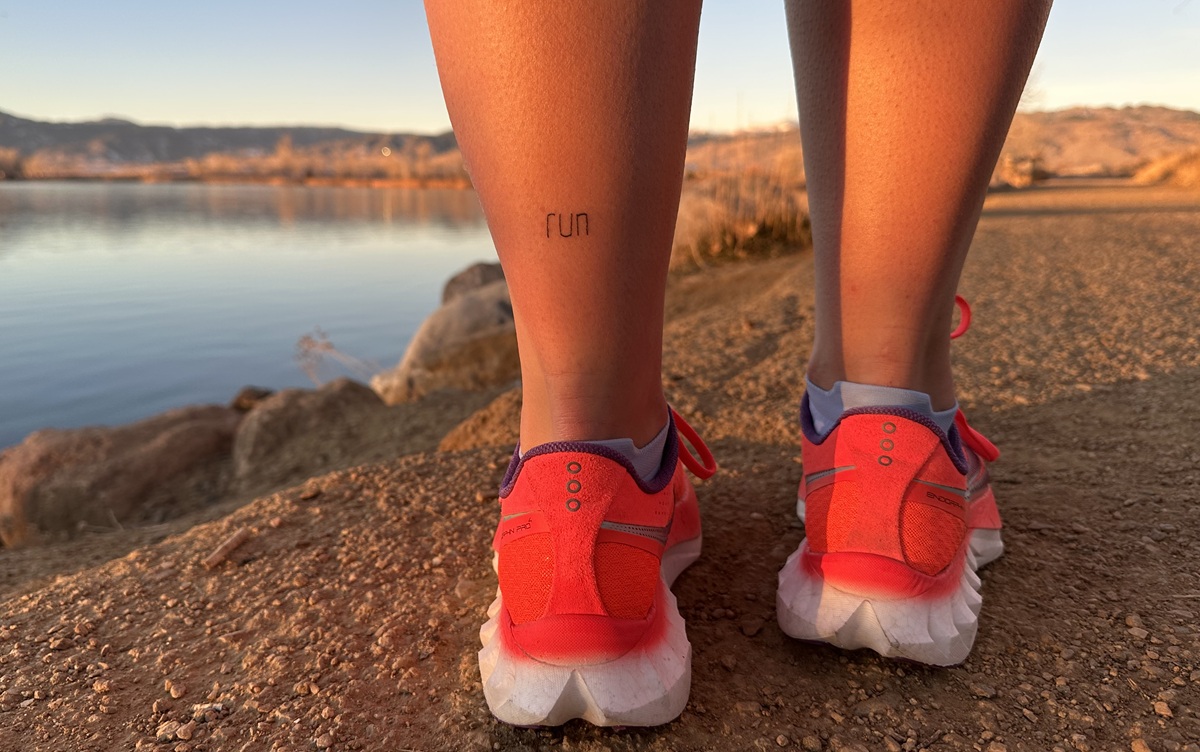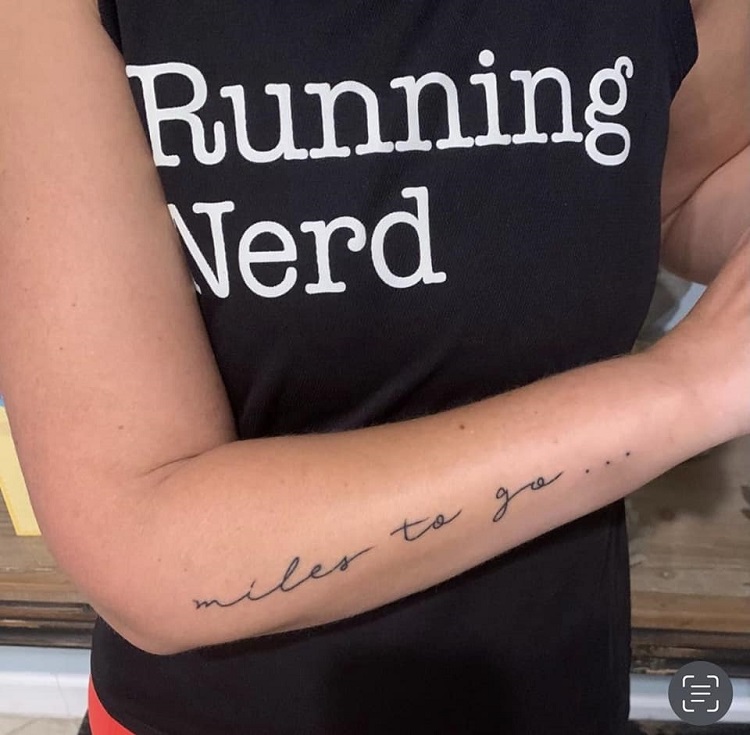Tattoos are such a fun way to tell your story, whether it’s to celebrate a big race, a mantra, or just something that makes you smile every time you look at it. But if you’re someone who loves to move (hello runners), you’ve probably wondered: How soon can I work out after getting a tattoo?

Running tattoos are some of my favorite things to see because they immediately identify someone to me as a kindred spirit. But no matter what your ink looks like, the goal is the same: let it heal properly so it lasts and doesn’t cause problems later.
To answer this question, we’ve looked at some of the best recommendations from artists with years of experience, right alongside the American Academy of Dermatology. So without further ado, let’s talk about when you can start sweating again, what to watch out for, and how to keep both your training and your tattoo in great shape.
When Can You Work Out After Getting a Tattoo
It’s usually safe to get back to workouts after getting a tattoo, but (yep, there’s a “but”) you’ll want to be smart about it while your skin is still healing. There aren’t any strict, across-the-board rules, but there are some solid guidelines, including recommendations from places like the Mayo Clinic.
Your tattoo is basically an open wound. And sweating into that fresh ink can irritate or even lead to infection
It’s not just the sweat that’s an issue either. Think about how often we touch weights, yoga mats, or gym equipment that haven’t been wiped down. Gyms are a breeding ground for bacteria, and your skin is more vulnerable than usual right now.
The biggest consideration is going to be the size and where it is. A very small item on your ankle, might easily be covered and you’re ready to run within a few days. A larger tattoo sleeve or Boston Marathon logo across your calf could require more time for the skin to fully recover.
First 24 Hours to 48 Hours
It is recommended to wait at least 24 hours after getting a tattoo before doing any high-impact or intense exercise. During this time, the tattoo will be sensitive and may bleed.
It’s important to keep the tattoo clean and dry, and to follow any aftercare instructions provided by the tattoo artist.

When it comes to certain types of tattoos, such as those with a lot of shading or coloring, it may be advisable to wait a bit longer before working out. This is because the ink can take longer to set, and the skin may be more susceptible to irritation or damage. It is best to consult with your tattoo artist for specific aftercare instructions based on the type of tattoo you have.
As for tattoos with color, there is no evidence to suggest that they require any different aftercare than black and grey tattoos.
First Week
Once the initial healing period has passed, it’s generally safe to resume light exercise. However, it’s important to avoid activities that involve a lot of sweating, such as running or hot yoga, for at least that first week. During this time, it’s best to stick to low-impact exercises like walking or gentle stretching.
2 to 3 Weeks
You’re likely now ready to start going back to more intense sweat sessions.
Of course, as with any injury you need to pay attention to how your body is now responding to the increase in body temperature, any scabs that are being irritated or pulled and anything that feels it limits your range of motion.
Tips for Working Out After a Tattoo
When resuming more intense exercise, it’s important you steps to protect the tattoo. This may include covering the tattoo with a bandage or wearing loose clothing that won’t rub against the tattoo. It’s also important to keep the tattoo clean and dry, and to avoid exposing it to dirty or contaminated surfaces.
1. Cover the Tattoo
If the tattoo is in an area that may rub against clothing like your socks on your ankle or shorts on a thigh, consider covering it with a bandage or gauze. Make sure to use a breathable, non-stick bandage to avoid trapping moisture against the tattoo.
But this leads us to our next tip.
2. Wear Loose Clothing
Avoid tight-fitting clothing that may rub against the tattoo and cause irritation and friction. Opt for loose, breathable clothing that won’t stick to the tattoo or trap sweat against the skin. Gals, that means avoid spandex tights or shorts and any high + tight fitted socks!
3. Avoid Excessive Sweating
Sweating can cause irritation and increase the risk of infection, so it’s important to avoid excessive sweating while the tattoo is healing. This may mean taking a break from high-intensity workouts or exercising in a cooler environment.
4. Avoid Excessive Stretching of the Skin
Remember that tattooed skin may feel a bit tight, but most importantly it’s healing. We don’t want to pull off the scab or open the wound. So now may not be the time for deep lunges with a new tattoo along your knees (yes I’ve seen some cool runners with new ink there).
You’ll also want to avoid a lot of jumping around like plyometrics for at least a week if that tattoo is on your leg(s).
5. Consider Direct Sunlight
Hello runner, are you heading out to get some Vitamin D? Make sure that tattoo remains covered for both initial healing and later it can help to prevent fading.
6. Clean the Tattoo
After working out, gently wash the tattoo with mild soap and warm water. Pat dry with a clean towel, taking care not to rub or irritate the tattoo.
Remember in the shower to be gentle! And you probably don’t want to be taking your hottest showers right at this moment because that will add to skin dryness.
If you’re going to the pool for cross training, experts suggest waiting around 3 weeks before getting into the water to avoid infection. Remember, the tattoo is technically an open wound!
7. Moisturize the Tattoo
Keeping the tattoo moisturized can help to prevent dryness and irritation. Use a fragrance-free, non-comedogenic lotion or ointment recommended by your tattoo artist or dermatologist.

It’s important to follow any aftercare instructions provided by your tattoo artist, as they may have specific recommendations based on the location and size of the tattoo. With proper care, your new tattoo can heal beautifully while you continue to enjoy your workout routine.
What About Lifting Weights After Getting a Tattoo?
In general, we would say 2-3 days. BUT the key here is how sweaty you’ll be getting during that workout.
So if you can be in front of a fan or simply take down the intensity a little bit (Or increase rest between sets) then you won’t heat up the body quite so much or start HEAVY sweating.
Placement matters in this case as well. If you have a new tattoo on your elbows, then maybe hold off the bench press. If you have a new thigh tattoo, maybe not the time to be doing hip thrusts with a barbell.
Be smart about your fresh tattoo and you should be fine with most workouts.
And don’t forget you can still get a great workout with bodyweight focused exercises!
When Not To Workout After Getting a Tattoo
If you’ve started back with your routine, but are having some discomfort it’s really important to make sure you don’t have an infection.
An infected tattoo can be a serious and potentially dangerous problem. It’s important to recognize the signs of an infection and seek medical attention promptly if you suspect that your tattoo is infected.
Here are some common signs of an infected tattoo:
- Redness and swelling: A small amount of redness and swelling is normal after getting a tattoo, but if the redness and swelling become more pronounced and spread beyond the immediate area of the tattoo, it could be a sign of infection.
- Warmth and tenderness: If the tattooed area feels warm to the touch or is unusually tender, it could be a sign of infection.
- Pus or discharge: If the tattoo is oozing pus or other fluid, it’s a sign that there is an infection present.
- Foul odor: If the tattoo emits a foul odor, it may be a sign of infection.
- Fever or chills: If you experience a fever, chills, or other flu-like symptoms, it could be a sign that the infection has spread beyond the tattooed area.
If you notice any of these, it’s important to seek medical attention right away. Your doctor may prescribe antibiotics or other treatments to clear up the infection and prevent it from spreading. In severe cases, hospitalization may be necessary.
Looking for other running tips?
- Discomfort vs Pain – when to stop and when to push
- 11 Marathon Training Secrets Everyone Needs to Know
- How to Combine Heavy Lifting and Running
Other ways to connect with Amanda
Instagram Daily Fun: RunToTheFinish
Facebook Community Chatter: RunToTheFinish
Sign Up to Receive a Weekly Newsletter with Top Running Tips and Laughs



 Best Walking Shoes for Plantar Fasciitis (Tested By Someone Who Actually Has It)
Best Walking Shoes for Plantar Fasciitis (Tested By Someone Who Actually Has It)
